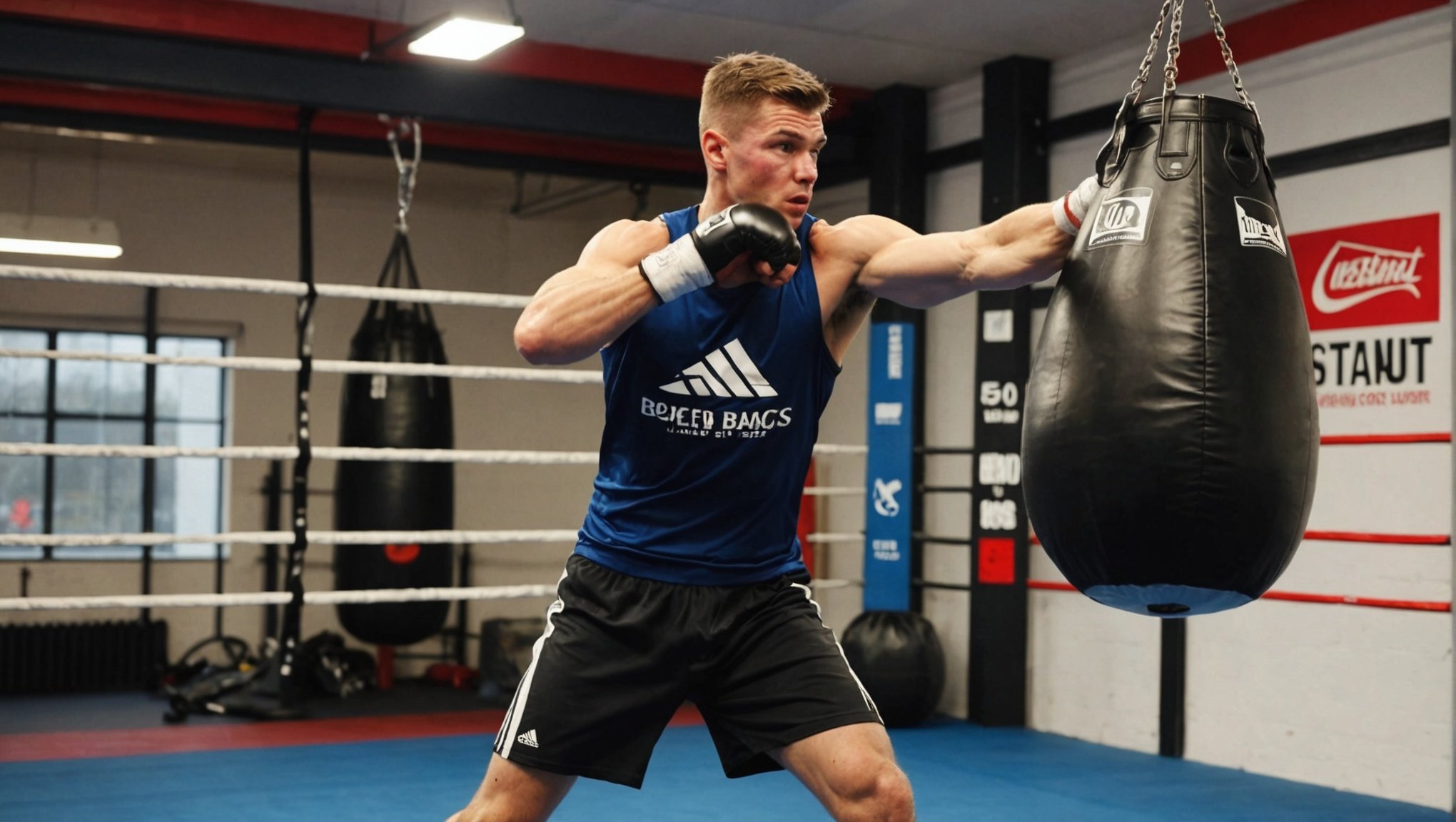Mastering Timing and Precision: The Ultimate Guide for UK Boxers on Using Speed Bags
Understanding the Importance of Speed Bag Training
When it comes to boxing, few pieces of equipment are as versatile and essential as the speed bag. This small, often underestimated bag is a cornerstone of any serious boxer’s training regimen. It’s not just about hitting a bag; it’s about developing the precision, timing, and hand speed that can make all the difference in the ring.
“Speed bags are one of the most underrated pieces of equipment in boxing,” says former professional boxer, Joe Smith. “They help you develop the hand-eye coordination and timing that you just can’t get from other types of training.”
Also read : Unlocking Striking Power: A Comprehensive Guide for UK Kickboxers on Using Resistance Bands
Setting Up Your Speed Bag
Before you start punching, it’s crucial to set up your speed bag correctly. Here are some steps to ensure you’re getting the most out of your training:
Choosing the Right Speed Bag
- Size and Weight: Speed bags come in various sizes and weights. Beginners might prefer a smaller, lighter bag to focus on speed and timing, while more advanced boxers might opt for a larger, heavier bag to build power.
- Material: Look for bags made from durable materials like leather or synthetic leather. These will withstand the constant pounding and last longer.
- Mounting: Ensure your speed bag is securely mounted. You can use a speed bag platform or attach it to a sturdy beam. The bag should be at a height that allows you to punch comfortably without straining your back or shoulders.
Adjusting the Bag
- Tension: Adjust the tension of the bag so it swings back and forth smoothly. If it’s too loose, it won’t provide enough resistance; if it’s too tight, it won’t swing properly.
- Positioning: Position the bag so that it’s directly in front of you and at a comfortable punching height.
Basic Techniques for Speed Bag Training
Mastering the speed bag involves more than just hitting it; it’s about developing a rhythm and timing that translates to real-world boxing scenarios.
This might interest you : Optimizing Nutrition for Muscle Recovery: A Guide for UK Combat Sports Athletes
Hand Positioning
- Keep your hands up in a guard position, with your gloves almost touching your face.
- Use your left hand (for orthodox boxers) to guide the bag and your right hand to punch.
Punching Techniques
- Jab-Cross Combination: Start with a simple jab-cross combination. Punch the bag with your left hand, then immediately follow with your right hand.
- Alternating Punches: Alternate punches between your left and right hands. Focus on quick, light punches rather than powerful ones.
- Circles and Figure-Eights: Move your hands in circular motions and figure-eights around the bag. This helps improve hand-eye coordination and timing.
Advanced Techniques for Enhanced Training
Once you’ve mastered the basics, it’s time to take your speed bag training to the next level.
Incorporating Footwork
- Practice shuffling, bobbing, and weaving while punching the speed bag. This simulates the movement you’ll experience in a real fight.
- Move around the bag, punching from different angles to improve your agility and reaction time.
Adding Power Punches
- Introduce power punches into your routine. Focus on throwing hooks, uppercuts, and straight punches.
- Use different parts of your gloves to hit the bag – the knuckles for straight punches and the palms for hooks.
Integrating Other Martial Arts Techniques
- Muay Thai: Incorporate Muay Thai techniques like elbow strikes and knee kicks into your speed bag training.
- Body Punches: Practice punching the bag with your body weight behind each punch, simulating body shots.
Benefits of Speed Bag Training
Speed bag training offers a multitude of benefits that can significantly enhance your boxing skills.
Hand Speed and Coordination
- Speed bags help you develop lightning-fast hand speed and improve your hand-eye coordination.
- “The speed bag is the best tool for improving hand speed,” says Mike Tyson, former world heavyweight champion. “It’s all about timing and rhythm.”
Eye Coordination
- The constant movement of the speed bag forces you to focus and react quickly, enhancing your eye coordination.
- “Eye coordination is key in boxing,” explains boxing coach, Mark DellaGrotte. “The speed bag helps you develop this skill in a way that other training methods can’t.”
Upper Body Strength and Endurance
- Speed bag training works your entire upper body, including your arms, shoulders, and back.
- “It’s a great way to build endurance and strength without feeling like you’re doing a traditional workout,” says amateur boxer, Sarah Jones.
Common Mistakes to Avoid
While speed bag training is incredibly beneficial, there are some common mistakes to watch out for.
Poor Hand Positioning
- Make sure to keep your hands up and your gloves close to your face to avoid taking unnecessary punches.
- “Keeping your hands up is crucial,” advises boxing trainer, Freddie Roach. “It protects you from injury and helps you stay focused.”
Inconsistent Rhythm
- Maintain a consistent rhythm when punching the speed bag. This helps you develop a natural timing that translates to real fights.
- “The key is to find a rhythm and stick to it,” says professional boxer, Canelo Alvarez. “It makes the training more effective and enjoyable.”
Overtraining
- Don’t overdo it. Speed bag training can be intense, so make sure to take breaks and rest your hands.
- “Rest is just as important as training,” emphasizes sports physiologist, Dr. Jordan Metzl. “Overtraining can lead to injuries and burnout.”
Practical Tips and Advice
Here are some practical tips to help you get the most out of your speed bag training:
Warm-Up and Cool-Down
- Always warm up before starting your speed bag training. Jumping rope, jogging, or doing some light shadowboxing can get your blood flowing.
- Cool down afterwards with some stretching to prevent muscle soreness.
Use Proper Gear
- Wear the right boxing gloves to protect your hands. Look for gloves with good padding and a snug fit.
- “Invest in good quality gloves,” advises boxing equipment expert, John Lee. “They make a big difference in your training.”
Train Regularly
- Consistency is key. Aim to train with the speed bag at least 2-3 times a week.
- “Regular training helps you develop muscle memory,” explains boxing coach, Teddy Atlas. “It’s what separates good boxers from great ones.”
Detailed Training Plan
Here’s a detailed training plan you can follow to incorporate speed bag training into your routine:
Weekly Training Schedule
| Day | Activity | Duration |
|---|---|---|
| Monday | Warm-up (jumping rope), Speed Bag (basic techniques) | 30 minutes |
| Tuesday | Footwork drills, Heavy Bag training | 45 minutes |
| Wednesday | Rest day | – |
| Thursday | Speed Bag (advanced techniques), Muay Thai drills | 45 minutes |
| Friday | Light sparring, Cool-down (stretching) | 30 minutes |
| Saturday | Rest day | – |
| Sunday | Long run or cardio workout | 60 minutes |
Sample Speed Bag Routine
- Warm-Up (5 minutes)
- Jumping rope or light shadowboxing
- Basic Techniques (10 minutes)
- Jab-cross combinations
- Alternating punches
- Circles and figure-eights
- Advanced Techniques (15 minutes)
- Incorporating footwork
- Adding power punches
- Muay Thai techniques
- Cool-Down (5 minutes)
- Stretching to prevent muscle soreness
Quotes and Insights from Boxing Experts
Here are some quotes and insights from boxing experts that highlight the importance of speed bag training:
- “The speed bag is an essential tool for any boxer. It helps you develop the timing and hand speed that are crucial in the ring.” – Mike Tyson
- “Speed bag training is not just about hitting a bag; it’s about developing a rhythm and timing that translates to real fights.” – Canelo Alvarez
- “The key to mastering the speed bag is consistency. Train regularly and you’ll see significant improvements in your hand speed and coordination.” – Teddy Atlas
Mastering the speed bag is a journey that requires dedication, patience, and practice. By understanding the importance of speed bag training, setting up your equipment correctly, mastering basic and advanced techniques, and avoiding common mistakes, you can significantly enhance your boxing skills.
Remember, the speed bag is not just a piece of equipment; it’s a tool that helps you develop the precision, timing, and hand speed that can make all the difference in your boxing career. So, lace up your boxing gloves, find your rhythm, and start punching your way to boxing greatness.













